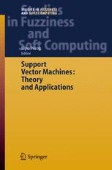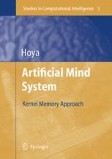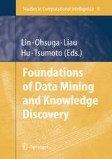Search
Search Results
-
Incremental Mining on Association Rules
The discovery of association rules has been known to be useful in selective marketing, decision analysis, and business management. An important...
-
Fuzzy Support Vector Machines with Automatic Membership Setting
Support vector machines like other classification approaches aim to learn the decision surface from the input points for classification problems or...
-
Epilogue – Towards Develo** A Realistic Sense of Artificial Intelligence
So far, we have considered how the artificial mind system based upon the holistic model as depicted in Fig. 5.1 (on page 84) works in terms of the...
-
Memory Modules and the Innate Structure
As the philosopher Miguel de Umamuno (1864-1936) once said, “We live in memory and memory, and our spiritual life is at bottom simply the effort of...
-
A Feature/Attribute Theory for Association Mining and Constructing the Complete Feature Set
A correct selection of features (attributes) is vital in data mining. For this aim, the complete set of features is constructed. Here are some...
-
Web Mining – Concepts, Applications and Research Directions
From its very beginning, the potential of extracting valuable knowledge from the Web has been quite evident. Web mining, i.e. the application of data...
-
Mining Association Rules from Tabular Data Guided by Maximal Frequent Itemsets
We propose the use of maximal frequent itemsets (MFIs) to derive association rules from tabular datasets. We first present an efficient method to...
-
CONCLUDING REMARKS
The choice of problems presented in this study is intended to emphasize that in some cases even the classical problems of acoustics can be addressed...
-
Fuzzy Subgroups of Abelian Groups
Some of the best examples of algebraic structure theory come from commutative group theory. Commutative group theory is also a principal reason for...
-
A Dynamic Model of Gene Regulatory Networks Based on Inertia Principle
In molecular biology, functions are produced by a set of macromolecules that interact at different levels. Genes and their products, proteins,...
-
A Comparative Investigation on Model Selection in Binary Factor Analysis
Binary factor analysis has been widely used in data analysis with various applications. Most studies assume a known hidden factors number k or...
-
Extraction of Generalized Rules with Automated Attribute Abstraction
We propose a novel method for mining generalized rules with high support and confidence. Using our method, we can obtain generalized rules in which...
-
Improved Knowledge Mining with the Multimethod Approach
Automatic induction from examples has a long tradition and represents an important technique used in data mining. Trough induction a method builds a...
-
A Careful Look at the Use of Statistical Methodology in Data Mining
Knowledge discovery in databases (KDD) is an inherently statistical activity, with a considerable literature drawing upon statistical science....
-
Logical Regression Analysis: From Mathematical Formulas to Linguistic Rules
Data mining means the discovery of knowledge from (a large amount of)data, and so data mining should provide not only predictions but also knowledge...
-
Privacy-Preserving Data Mining
The growth of data mining has raised concerns among privacy advocates. Some of this is based on a misunderstanding of what data mining does. The...
-
COGNITIVE PROCESSING IN ACOUSTICS
The idea of vagueness (contrary to bi-valent logic) appeared at the end of the 19th century, and was formally applied to the field of logic in 1923...
-
Free Fuzzy Subgroups and Fuzzy Subgroup Presentations
In this chapter, we define a notion of a free fuzzy subgroup and study its basic properties. We examine two approaches. The first approach is based...
-
Active-Set Methods for Support Vector Machines
This chapter describes an active-set algorithm for quadratic programming problems that arise from the computation of support vector machines (SVMs)....
-
The Self-Organising Kernel Memory (SOKM)
In the previous chapter, various topological representations in terms of the kernel memory concept have been discussed together with some...
